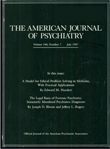Current status and future directions of research on the American Indian child
Abstract
American Indians are the most severely disadvantaged of any population within the United States. By adolescence, Indian children show higher rates of suicide, alcoholism, drug abuse, delinquency, and out-of-home placement. School achievement is severely compromised, and many youths drop out before graduation from high school. The Indian child understands the environment through intuitive, visual, and pictorial means, but success in the Anglo school is largely dependent on auditory processing, abstract conceptualization, and language skills. This difference compounds existing problems of poverty, dislocation, alienation, depression and intergenerational conflict and can partially account for the higher rate of emotional and behavioral problems among Indian adolescents.
Access content
To read the fulltext, please use one of the options below to sign in or purchase access.- Personal login
- Institutional Login
- Sign in via OpenAthens
- Register for access
-
Please login/register if you wish to pair your device and check access availability.
Not a subscriber?
PsychiatryOnline subscription options offer access to the DSM-5 library, books, journals, CME, and patient resources. This all-in-one virtual library provides psychiatrists and mental health professionals with key resources for diagnosis, treatment, research, and professional development.
Need more help? PsychiatryOnline Customer Service may be reached by emailing [email protected] or by calling 800-368-5777 (in the U.S.) or 703-907-7322 (outside the U.S.).



